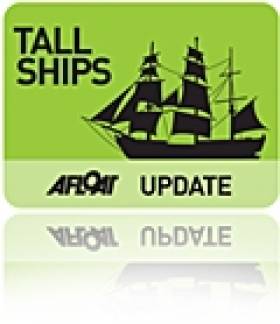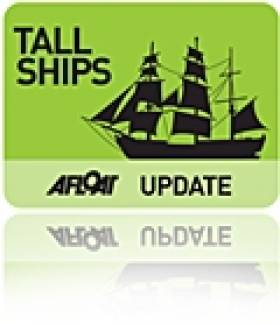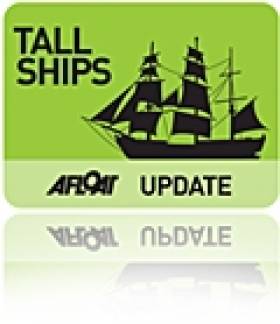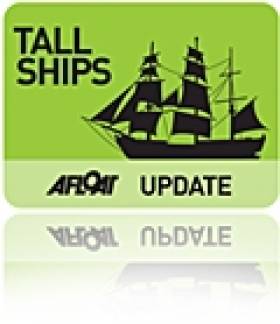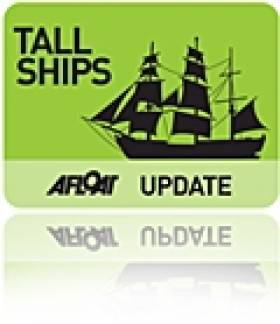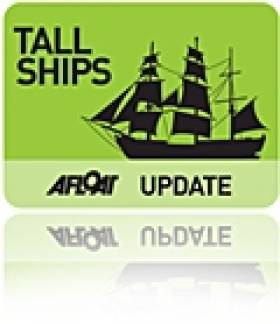Displaying items by tag: Tall Ships
The 'Jeanie' Returns to Liffey Quays to Reopen Tomorrow
#JeanieReturns – Replica 19th century barque Jeanie Johnston has finally returned to her dedicated Dublin Liffey berth along Custom House Quay having had some delays following essential maintenance in a drydock, writes Jehan Ashmore.
The good news is that guided tours of the famine emigrant museum tallship will reopen from 1100 am tomorrow (Friday 7 November). For further information click HERE.
In recent days the barque has been undergoing finishing touches while at a temporary lay-by berth close to the East Link Bridge.
Beforehand the Tralee registered replica had been dry-docked for essential maintenance having entered the Dublin Graving Docks Ltd facility almost a month ago. The shiprepair and conversion business faces closure due to plans to redevelop Alexandra Basin by Dublin Port Company.
The work on the barque was her third and also the most extensive carried out in the shiprepair and conversion facility since her purchase more than a decade ago by the Dublin Docklands Development Authority (DDDA).
Sister tugs Beaufort and Shackleton from Dublin Port Company repeated the exercise of returning the Jeanie Johnston to her city-centre berth at Dublin City Moorings. This involved a short tow upriver having transited through the East-Link toll lift-bridge and the Samuel Beckett swing bridge.
The pontoon facility at Custom House Quay was installed by the DDDA as part of a river Liffey rejuvenation project to attract visiting yachts. In addition to generating waterborne activity in an attempt to emulate other European capitals which have a vibrant river or waterfront setting.
Jeanie Johnston Tours 'Not' Open Due to Continued Essential Maintenance
#JeanieNotOpen – According to the Jeanie Johnston website, tours of the replica 19th barque are 'not' available at present, it transpires that essential maintenance is still been carried out on board.
The announcement (click HERE) from the operators of the visitor attraction continued to read that they expect to reopen soon, however they ask that those wishing to seek up to date details regarding availability should email them.
The email is [email protected], for further general information about the replica famine emigrant ship that sailed to the New World, click to the above 'announcement' link.
As previously reported, Jeanie Johnston departed Dublin Graving Dock on Thursday, having undergone an overhaul and that she was due to reopen today.
The Tralee registered barque currently remains moored alongside a berth close to the East-Link Bridge. When work is completed she will make the short journey upriver to her designated berth at Custom House Quay.
#JeanieJohnston - Jeanie Johnston departed Dublin Graving Docks today following the replica 19th barque's most extensive maintenance work since her purchase by the DDDA more than a decade ago, writes Jehan Ashmore.
She is scheduled to resume her famine emigrant museum ship role with tours starting this Saturday (1 November).
Among the work carried out by the dockyard which faces closure as previously reported, was cleaning of her hull, removal of debris notably along the waterline and timber replaced where necessary in addition to repainting.
Graving Dock No.2 was flooded to allow the replica tallship to vacate from the Alexandra Basin based ship-repair facility with tug assistance to her current lay by berth next to the East-Link Bridge.
She will then continue her final short leg upriver with a transit also involving the opening of the Samuel Beckett swing –bridge to moor along her usual Custom House Quay berth.
The visitor attraction which had 20,000 visitors to date this year, tells the story of the famine and the emigrant carrying barque whuch sailed to the New World. Between 1848-1855 she carried more than 2,500 people from Ireland on 16 crossings to North America.
A bonus for the museum ship has been a rise in Canadian tourists due to more flight capacity. They are drawn to the museum ship as the original Jeanie Johnston was built in Quebec in 1847 along the St. Lawrence River.
Weather Delays Departure of Sales-Listed Sail Trainer through East-Link Toll Bridge
#WeatherBound – Following yesterday's 30th anniversary of the East-Link Toll Lift Bridge as previously reported, the UK flagged STV Stavros S. Niarchos and OPV L.E. Aisling (P23) both made transits through the Liffey road crossing this morning, writes Jehan Ashmore.
The departing vessels had moored at neighbouring berths along Sir John Rogersons Quay, from where the Naval Service 'Emer' class OPV firstly vacated having arrived in Dublin Port the previous day.
Within the hour so did the sale-listed STV Stavros S. Niarchos which cast off lines to head downriver having had to delay her departure yesterday due to weather bound conditions. The sail-training vessel is heading for Warrenpoint.
At 60m (197ft) long she is the largest brig built for over a century in the UK when completed in 2000. The brig is the main vessel of the sail training fleet run by the Tall Ships Youth Trust which offers sailing experience for those aged from 18 to 80. She arrived to the capital from last week and to embark new sailing recruits for a voyage that terminates in Liverpool.
As reported before on Afloat.ie, she flies the Stena houseflag as the three-masted vessel is unique among Northern Marine Management (part of the Stena Group) pool of around 130 vessels that include ro-ro tonnage to very large crude carrier (VLCC) tankers.
#TallshipImposter –At first glance anyone along the Liffey this afternoon could be forgiven to conclude Jeanie Johnston was returning from dry-dock to her dedicated northside Liffey berth, however as a tallship sailed up Dublin's city quays she instead notably berthed at the south quays and dismissed any such theory, writes Jehan Ashmore.
The Custom House Quay berth is where Jeanie Johnston is normally stationed as a static museum ship however her dry-docking period has been extended. Originally, the replica barque was due to return next week from Dublin Graving Docks, though on-going maintenance works has re-scheduled her reopening date as a tourist attraction to 1 November.
So what is the identity of this other tallship?... Afloat.ie can reveal she is the STV Stavros S Niarchos, a sail-training vessel and likewise of Jeanie Johnston is also rigged as an 19th century ship but based on that of a brig.
She is visiting Dublin Port on her own business having completed a voyage overnight from Waterford. Her arrival this afternoon followed an en route anchorage off Scotsmens Bay until she berthed in the capital this afternoon at Sir John Rogerson's Quay.
The 60m (200ft) long UK tallship operated by The Tall Ships Youth Trust is understood to have concluded a voyage in the capital and is to embark new sailors on another cruise to Liverpool.
The 493 tonnes vessel was scheduled to depart for Merseyside on Monday, however it would appear this has been changed to the following Tuesday, in which the next voyage of 6 nights taking en route ports is catered for those aged 18 and 80 young! year olds.
The cost of the voyage which requires no sailing experience is £179 sterling (excluding other charges) and where all those who sail with her get to experience setting 18 sails across 5 yards of the masts.
The Trust which was formerly The Sail Training Association, is a registered charity founded in 1956 that is dedicated to the personal development of young people through the crewing of ocean going sail training vessels.
Having taken 100,000 trainees to sea and sailed 1.9 million nautical miles, the Stavros S Niarchos which was completed in 2000 at Appledore Shipbuilders, Devon is currently sale-listed.
As a sail training vessel would the brig be suited as Asgard II's replacement?
#JeanieJohnston - Jeanie Johnston which is undergoing maintenance at Dublin Graving Docks Ltd was joined this week by Dutch flagged Arklow Rambler at the ship-repair facility that faces closure by Dublin Port Company over plans to redevelop Alexandra Basin, writes Jehan Ashmore.
As previously reported, Dublin Graving Docks which employs around 26 people at a site within the port estate area of Alexandra Basin is where DPC propose a €200m project to accommodate much bigger cruise ships at a dedicated terminal as outlined at a recent planning hearing by An Bord Pleanála.
Dublin Graving Docks which operates the port-owned 200m long graving dock is the only ship-repairer and conversion business left remaining in the country's largest port.
However the Alexandra Basin Redevelopment (ABR) project (see website) for cruise berths would also involve a reconfiguration of other berths throughout the basin. In addition the plans are to enable larger deep-drafted cargoships and more quayside space to include the site of the dry dock.
Currently trade throughput is around 29 million tonnes though the port's strategy is to plan ahead so to handle 40 million tonnes by 2040. This is where the ABR forms phase one of the Dublin Port Company's Masterplan (2012-2040) which sets out the future of the port over the next four decades.
Jeanie Johnston is a replica 19th century barque based on the original built in Quebec Canada in 1847 that transported 2,500 people to North America. Since her acquisition by Dublin Docklands Development Authority (DDDA) in 2005, she has been dry-docked twice at the nearby facility.
The DDDA brought the Tralee registered tallship as part of a river regeneration project and appointed Aiseanna Mara Teoranta on their behalf to operate the vessel as a tourist attraction.
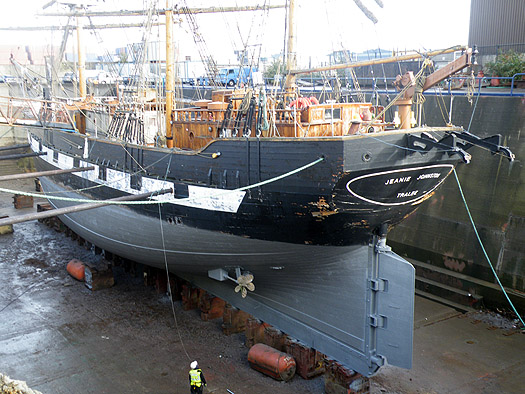
Jeanie Johnston, the replica 19th century barque is undergoing her most extensive maintenance dry-docking since DDDA's purchase in 2002. She is seen as a fresh layer of primer paint is applied to her timber hull. Photo Jehan Ashmore
Last year she welcomed 20,000 visitors and this year there has been a rise in Canadian tourists due to more flights to Ireland, in which they have heard the story on board of how Irish emigrants fled the famine and sought a better life in the New World.
As she lays in Graving Dock No.2, this is a far removed environment to her role at her berth close to the Convention Centre.
Her maintenance programme requires intensive cleaning of her hull, removal of debris notably along the waterline and any replacement of timber plus applying layers of paint. On completion of the work she is to return shipshape and resume her museum role on 1 November.
#JeanieJohnston - The replica 19th barque Jeanie Johnston departed her role as a static famine emigrant museum ship along Dublin's Custom House Quay, as she is to undergo 'essential maintenance', writes Jehan Ashmore.
Jeanie Johnston's short tow downriver was carried out by Dublin Port Company tug sisters, Beaufort and Shackleton, which involved transiting through two bridges, firstly the Samuel Beckett swing-bridge and then the East-Link toll-lift bridge.
The three masted vessel temporally moored alongside the North Quay Wall Extension next to the East-Link where the tugs are stationed. As of this morning she berthed alongside the lead-in jetty of Dublin Graving Docks Ltd's facility within Alexandra Basin. Again this operation involved the pair of tugs in which the Shackleton had only recently vacated the same graving dock.
Due to the dry-docking, tours of the replica tallship will not be available from today, however they are due to resume on 22 October. The 50 minute tours tell the story of how Irish emigrants during the famine departed these shores in the hope of survival and seeking a future in the 'New World'.
The original Jeanie Johnston was built in Quebec, Canada in 1847. She carried more than 2,500 people from Ireland on 16 crossings to North America between 1848 to 1855.
As for the replica, she became the floating museum following a short-lived career 'sailing' around Irish ports and several trips to Spain. Her high-point was the 'reinactment' voyage from Tralee to North America in 2003 with calls to U.S. and Canada.
In 2005, she took part in the Tall Ships Races from Waterford and in that same year she was brought by the Dublin Docklands Development Authority to become her present role as a city-centre tourist attraction.
At the time of her sale by Tralee Town Council and Kerry County Council, there were fears that the barque built in Tralee, Co. Kerry, amid controversial circumstances and cost overruns would be sold abroad and never to return.
Following the sinking of the state owned STV Asgard II in 2008, there were calls for Jeanie Johnston to be reactivated as a sail training vessel to replace the brigantine lost off Brittany.
Engine Failure Preceded Astrid Incident Says Interim Report
#Astrid - Engine failure led to the grounding of the tall ship Astrid off the Cork coast a year ago, according to an interim report by marine investigators.
The 42m Dutch brig's 30-strong crew, most of them sail trainees, were rescued in a major operation after it ran onto rocks between Oysterhaven and Kinsale in choppy seas during last summer's ISA-organised Gathering Cruise.
Built in 1918 and in service as a cargo vessel till 1975, the tall ship foundered in the same spot where the barque Falls of Garry sank in 1911.
The Irish Times reports on the Marine Casualty Investigation Board's (MCIB) findings ahead of its final report to come after "the natural justice procedure".
Dutch authorities are involved in the Irish-led investigation that began in the days after the Astrid accident. There is as yet no indication as to what caused the vessel's engine to fail.
Belfast Secures Support For Tall Ships Return Next Summer
#TallShips - It's confirmed: Belfast will host the start of 2015's international Tall Ships Races.
According to BBC News, the tall ships will return to Belfast Lough for the first time since 2009 to coincide with next July's Titanic Maritime Festival.
The news follows more than two-and-a-half years from the original announcement by Belfast City Council, which has since secured sponsorship for its hosting of the event from German supermarket chain Lidl.
The tall-masted fleet's return to Irish shores will come three years after Dublin hosted the Tall Ships Races Festival.
BBC News has more on the story HERE.
Maritime Ireland Deserves a Tall Ship
#tallship – You come across a reference to an island nation - the 20th largest in the world - that doesn't have a marine policy or a dedicated marine department, and you think it must be some kind of a joke. It's a ship of state without a captain, or a rudder. It adds insult to injury to discover that this same island nation was moved to the verge of bankruptcy after her inhabitants turned their backs on the ocean and invested too heavily in the land.
So much for living in a smart economy.
Not many people living in Ireland realise that it's the third biggest country in Europe, by virtue of her seabed territory of 220 million acres.
Ask any fisherman what EU membership did for our trawler fleet and you will get a quick answer. Ireland has two–thirds of European fishing waters and 3 per cent of the catch. That sell-out, as the fishing community saw it, was the beginning of the end of marine policy in Ireland.
We have in the past been able to blame a lot of our maritime ignorance on the British, with a little justification. Boat ownership by the 'native Irish' was restricted at times, and fishing permitted only by licence. But that was 400 years ago, so we're running out of excuses.
If you're searching for a recent symbol of this marine neglect, look no further than Asgard II. At 30 years old, the boat was at the end of her working life when she sank off the coast of France in 2008.
She was our maritime flagship, a national icon which had given 10,000 young people the chance to go to sea. The insurance money paid out and it went into central exchequer funds. The State showed no interest in replacing her. Until now perhaps?
There has been some sort of maritime awakening in official Ireland. In June, the Government hosted an Ocean Wealth conference declaring millions could be 'harnessed' from our seas in so many ways.
Separately, a new naval patrol vessel has arrived at a cost of E54m. Another one is expected next year. This month the Taoiseach announced he'd ordered a third.
Is it all coincidence or is Ireland moving towards a new marine game plan?
There's no doubting the public's interest in our seas.Just look at the interest in the maritime festivals around our coast this summer and the crowds that came to see Spain's 'Juan Sebastián de Elcano', the world's third largest Tall Ship in Dublin port in June.
Now there is fresh State impetus in the marine, there should in tandem be plans to replace Ireland's Tall Ship, a symbol of our maritime heritage and the possibilities offered in the seas that surround us.


























